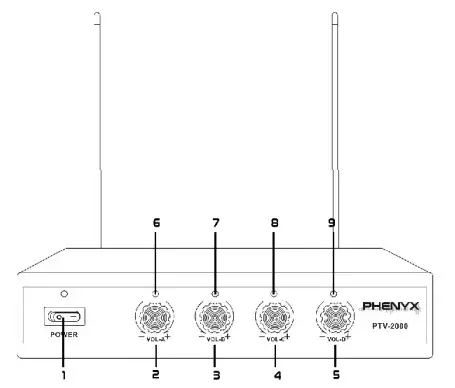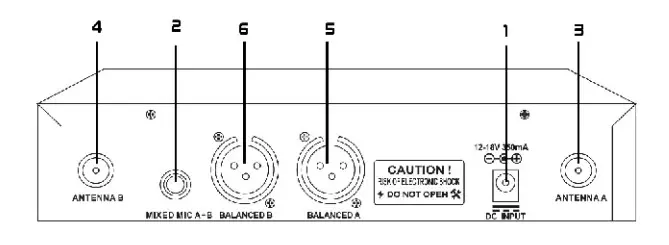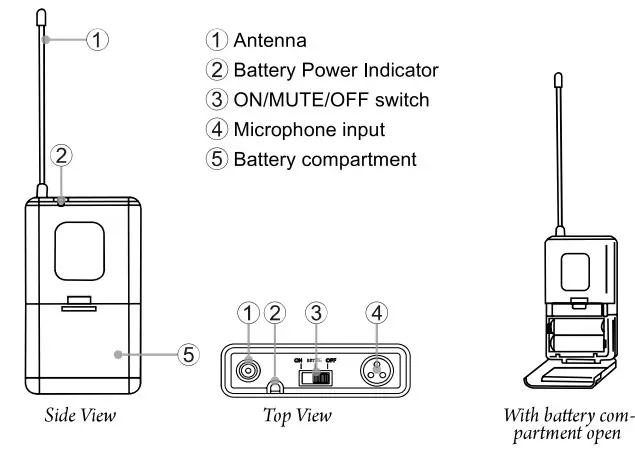 PTV-2O0O0Phoenix Pro PTV-2000 4-Channel VHF FixedFrequency Wireless Microphone System
PTV-2O0O0Phoenix Pro PTV-2000 4-Channel VHF FixedFrequency Wireless Microphone System
 OWNER’S MANUAL
OWNER’S MANUAL
Thank you for purchasing the HENYX PRO PTV-2000 4-Channel VHF Fixed Frequency Wireless Microphone System. Please read this manual carefully to ensure proper use and operation, and keep it for future reference.
System Description
Box contents
PTV-2000:
- 4 Channel VHF wireless receiver with balanced XLR and mixed %” outputs
- 2 antennas
- 4 VHF wireless handheld microphones
- 8 AA battery
- Power adapter 6.5mm audio cable
System overview
The PTV-2000 is the 4-channle VHF fixed frequency wireless microphone system developed by Phenxy Technology, a truly reliable and affordable solution for wireless performance. The setup and operation of this system is very quick and simple. It also uses the high performance of voice compression and expansion technology to ensure its true and clear sound quality. Microphones are equipped with an anti-shock ring that features stable and reliable outdoor performances, ideal for conference rooms, classrooms, dance halls, KTV rooms, churches, and parties. Operating distance is up to 200ft line of sight in open space.
Receiver for PTV-2000
Front Panel

- Power switch
- Volume B Control
- Volume A control: Adjust the volume output of Channel A
- Volume D Control
- Volume C Control
- RFA: CHA wireless. signal indicator
- RFB: CHB wireless signal indicator
- RFC: CHC wireless signal indicator
- RFD: CHD wireless signal indicator
Back Panel

- Power jack Connect AC/DC adapter to the receiver
- %” audio output jack Connect the audio cable from this jack to the input port of amplifier, mixer, or other PA systems
- Antenna A
- Antenna B
- Balanced A: Balanced XLR output for CHA and CHB
- Balanced B: Balanced XLR output for CHC and CHD
Transmitters
Handheld Microphone

- Battery power indicator
- ON/MUTE/OFF switch
- Battery compartment cover
Under normal operation, the battery power indicator (1) will briefly light up when powering on the microphone.If the battery power indicator (1) stays continuously on after powering on the microphone, the batteries must be replaced. To replace the batteries, proceed as follows:
- Unscrew the battery compartment cover (3) and set it aside
- After removing the old batteries, insert new ones, making sure to respect proper polarity
- Screw the battery compartment cover (3) back in placeIf the system is not to be used for long periods of time, remove the batteries from the transmitter and unplug the power adapter from the receiver and the main outlet. This can avoid damage when the system is not in use.
Bodypack
The Phenix VHF bodypack is to be used with the Phenix lavalier microphone & headsets.

Set-Up:
- Secure the bodypack to clothing, belt, or pocket.
- (a) For a lavalier microphone, clip the microphone to clothing about 1 foot under the mouth.(b) For a headset, install a headset comfortably on the head so the microphone can be placed close to the mouth.
- Connect the microphone audio connector to the bodypack microphone input (4)
- Turn the bodypack on by sliding the ON/MUTE/OFF switch to the “ON” position. The battery power indicator (2) will light up briery, indicating that the batteries have sufficient power.If the battery power indicator (3) stays continuously on after powering on the bodypack, the batteries must be replaced.To replace the batteries,proceed as follows:• Open the battery compartment door by pushing on the door sides and pulling it open• After removing the old batteries, insert new ones, making sure to respect proper polarity• Close the compartment by gently pushing the compartment door until it clicks
Operating Instructions
Set up
- Install fresh batteries in the transmitters (fresh to the section relative to the specific transmitter you are using).
- Connect the AC power adapter to a wall outlet and to the back of the receiver.
- Screw antenna A, B in, and position them 60 degrees apart from each other.
- Connect one of the two outputs available at the back panel to the next stage in your system. Typically, use the 1/4″ output to connect to unbalanced equipment such as consumer-level receivers, amplifiers, and mixers. Connect to professional equipment using the XLR output (cable not included).
- Making sure the volume of your speakers is off, turn on the receiver and the transmitters. The RF LED lights up, indicating that the corresponding transmitter is paired with the receiver.
- Turn the volume of your speakers back on and start increasing the volume of the transmitters until the proper volume is achieved.
Operation
For better results, keep the transmitter at least 2′ away from the receiver but within the transmitter’s range (200ft). Keep the transmitters in a direct line of sight with the receiver whenever possible. Electronics devices such as mobile phones, radios, and other transmitting devices may interfere with the wireless system transmitters. Please keep transmitter and receiver away from those devices and other possible interfering sources.
Troubleshooting Tips
|
ISSUE |
REASON |
SOLUTION |
| The transmitter battery indicator is rapidly flashing or continuously ON | The batteries are low | Replace with fresh batteries |
| A howling noise (also known as “feedback”) can be heard from the speakers | The microphone is too close to the speaker | Increase the dis- tance between the microphone and the speaker Avoid pointing the microphone directly at the speaker |
| No sound coming to the receiver | The wireless microphone is outside of the receiver’s range | Keep wireless microphone within operating range of the receiver |
| The wireless transmitter is off or muted (switch set to “OFF” or “MUTE”) | Turn wireless microphone on. Replace batteries if necessary | |
| Sound reaches the receiver, but no sound coming from the receiver | Volume control too low | Turn up the output volume by turning the volume control buttons in the front of the receiver clockwise. |
| Output is not (or wrongly) connected | Verify all connections to the rest of your system. Try different connection cables if available. |
If the product is defective or for all inquiries including warranty cover, please email [email protected]
Specifications
Overall System
| Carrier Frequency | 220 MHz-280MHz(Frequency of operation depends on local regulations) |
| Frequency Stability | 0.003% |
| Dynamic Range | >100dB |
| T.H.D | <0.5% |
| Frequency Response | 50Hz-18kHz |
| Outputs | XLR balanced mixed; ” unbalanced mixed |
| Audio Output Level | 0-500mV |
| Range | 200ft(actual range depends on local conditions) |
| Operating temperature | -10 C-4-50 C |
Receiver
| Power | 10mW |
| Power | 5W |
| S/N | >103 dB (1kHz-A) |
| Image Rejection | > 110dB |
| Spurious Rejection | > 90dB |
| Sensitivity | -105dBm |
| XLR Output | Pin 1: Ground Pin 2: (+) Pin 3: (-) |
| Power | DC12-18V, Current: 400mA, External power adaptor |
Handheld & Bodypack Transmitter
| Modulation Mode | FM |
| Maximum Deviation | 75kHz |
| Size | Handheld: 239 x 49 mm Bodypack: 110 x 63 x 20 mm |
| Weight (without batteries) | Handheld: 181g Bodypack: 66g |
| Power requirements | 2 AA alkaline or rechargeable batteries per transmitter |
| Battery life | about 8 hours |
Warranty Information & Technical Support
Our Warranty to you:Phoenix Technologies (“Phenix”) warrants Phenyx products against evident defects in material and workmanship for a period of one year from the date of original purchase for use. This warranty is valid exclusively in the US and applies only to the original owner. Ifyou discover a defect covered by this warranty, Phenyx will repair or replace the product at our sole discretion using new or refurbished components. Performance of repairs or replacements under this Warranty is sub-get to the registration of your product at www.phenyxusa.com/registerproduct.
Product failures not covered by this warranty:This warranty covers defects in manufacturing that arise from the correct use of the device. It is limited to defects in materials or workmanship and does not cover electrical or mechanical damage resulting from abuse, misuse, unauthorized Modi cation, lack of reasonable care, extreme heat, cold, damage due to natural forces, or corrosive environments. This warranty does not cover the normal wear and tear on covers, housing, connectors, and accessories.
Limits of liability:If your Phoenix product fails or does not perform as warranted, your sole recourse shall be to replace or repair it as described above. Phoenix will not be liable to you or anyone else for any damages that result from the failure of this product. These damages include, but are not limited to, the following: lost pro ts, lost savings, lost data, damage to other equipment, and incidental or consequential damages arising from the use of or inability to use this product. IN EVENT PHENYX SHALL BE LIABLE FOR MORE THAN THE AMOUNT OF YOUR PURCHASE PRICE, NOT TO EXCEED THE CURRENT LIST PRICE OF THE PRODUCT.
How to obtain service under this warranty:Please contact us at [email protected] or [email protected] with any questions or concerns about your products and a Phenyx Pro representative will contact you to provide assistance. You can also reach us through Facebook page http://www.facebook.com/phenyxusa/, our official website: www.phenyxusa.com, or our shopping website: www.phenyxpro.com.


[xyz-ips snippet=”download-snippet”]

